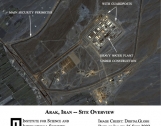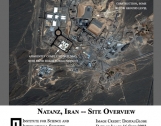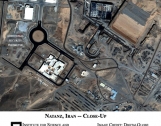Reports
Iran Building Nuclear Fuel Cycle Facilities: International Transparency Needed
by David Albright and Corey Hinderstein
December 12, 2002
Satellite images of two sites in Iran show the construction of secret nuclear fuel cycle facilities, according to ISIS assessments and confidential sources. This information was confirmed by CNN and reported on December 12, 2002. The facilities in the two satellite images appear related to the production of enriched uranium and heavy water, two materials that may be used in a civil nuclear program or in the production of nuclear weapons.
The International Atomic Energy Agency (IAEA) wants to visit these and possibly other sites and start inspections of them. However, the IAEA has so far been unsuccessful in visiting these sites. Iran is a signatory of the Nuclear Non-Proliferation Treaty (NPT) and has committed to renouncing the possession of nuclear weapons and permitting inspections by the IAEA of all its nuclear activities.
Under its safeguards agreement, Iran is not required to allow IAEA inspections of a new nuclear facility until six months before nuclear material is introduced into it. However, under strengthening measures requested by the IAEA in the 1990s, many other governments have agreed to provide the IAEA with information about a new facility six months before the start of its construction. So far, Iran has refused to agree to this new measure to take effect.
IAEA Director General Mohammed El Baradei was scheduled to arrive this week in Iran to discuss safeguards issues, visit these sites, and meet with Iranian President Ali Mohammad Khatami. However, the Iranian government canceled his delegation’s visit. In late November 2002, El Baradei told Newsday that he hoped to visit Iranian sites that may be a part of efforts to acquire a complete nuclear fuel cycle.
El Baradei’s visit had been postponed before. The visit is currently expected to occur in February 2003.
ISIS has acquired satellite imagery of the two areas in Iran. These areas were located following the release of information in August 2002 by the Iranian opposition group called the National Council of Resistance of Iran. Using information released by this group, ISIS located and purchased Digital Globe satellite images of the two sites.
ISIS has confirmed through photo interpretation that one of the sites, near a town called Arak, appears to be a heavy water plant under construction. Heavy water, which is ordinary water enriched in the hydrogen isotope deuterium, is used as a moderator in one type of nuclear reactor. For a satellite and ground level views of different heavy water plants, see this article on the ISIS website.
The existence of this site increases suspicions that Iran may be building a heavy-water moderated reactor. ISIS has been unable so far to locate such a reactor, completed or under construction. The power reactor under construction at Bushehr does not use heavy water. Iran’s existing research reactors do not use heavy water or too little heavy water to justify a heavy water production facility.
The Iranian opposition group said that the second site, called Natanz and located about 25 miles southeast of the city of Kashan, has a fuel fabrication facility. Based on the second satellite image and other sources, however, ISIS assesses that it is unlikely that the site contains a fuel fabrication facility, but it possibly has a uranium enrichment plant. Based on the nature of the buildings, the most likely type of enrichment plant is a gas centrifuge facility. The facility does not appear to be operating.
Iran stated at the IAEA General Conference in September 2002 in Vienna that it was pursuing a “long term plan” to construct “nuclear power plants and the associated technologies such as fuel cycle” facilities. A few years ago, a senior Iranian official told ISIS that Iran was pursuing a complete fuel cycle.
There is concern that this effort to obtain a complete fuel cycle is aimed at developing the capability to make separated plutonium and highly enriched uranium, the two main nuclear explosive materials. Evidence that Iran is acquiring fuel cycle technology without IAEA supervision increases suspicions about Iran’s activities. At a minimum, Iran needs to open these sites to IAEA inspectors and be fully transparent about their purpose. By their very nature, these types of facilities are dual-use. They can be built as civil facilities and can be relatively quickly converted to produce material aimed at making nuclear weapons. Alternatively, they can be copied and build clandestinely.
Under the NPT, Iran has a traditional safeguards agreement in place. Iran has not accepted the IAEA Model Additional Protocol, which was developed in the 1990s and significantly strengthens safeguards and the IAEA’s ability to detect undeclared nuclear activities.
These photos were purchased as part of a longer term ISIS project aimed at assessing Iran’s nuclear infrastructure and finding ways to increase transparency of Iranian nuclear activities.





 twitter
twitter